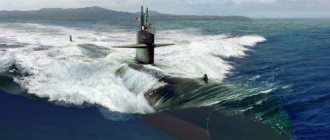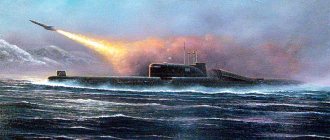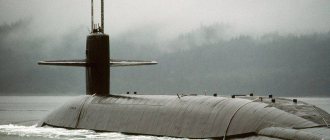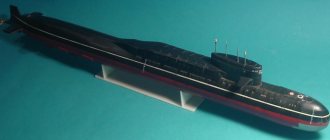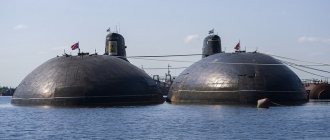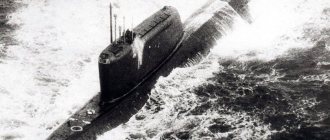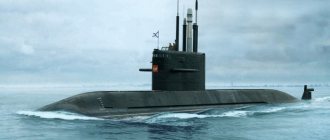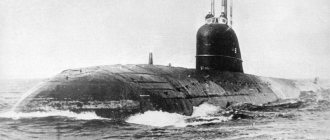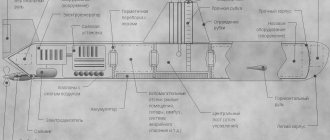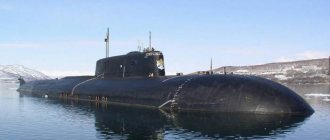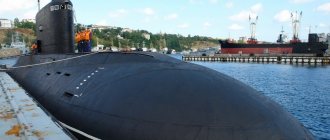| Ship name | Factory number | Dates | Notes | |||
| bookmarks | descent | entry into service | ||||
| SEVERODVINSK: Northern Machine-Building Enterprise (Shipyard No. 402) (16) | ||||||
| 1 | K-166 | 530 | 30.05.1961 | 06.09.1962 | 31.10.1963 | 1978 - transl. V K-71 1992 - transl. |
| 2 | K-104 | 531 | 11.01.1962 | 16.06.1963 | 16.12.1963 | 1981 - mod. according to the project 675MK 1992 - transl. |
| 3 | K-170 | 532 | 16.05.1962 | 04.08.1963 | 26.12.1963 | 1978 - transl. V K-86 1980 - mod. |
| 4 | K-172 | 533 | 08.08.1962 | 25.12.1963 | 30.07.1964 | 1978 - transl. V K-192 1992 - transl. |
| 5 | K-47 | 534 | 07.08.1962 | 10.02.1964 | 31.08.1964 | 1972 - mod. according to the project 675K 1992 - transl. |
| 6 | K-1 | 535 | 11.01.1963 | 30.04.1964 | 30.09.1964 | 1985 - mod. according to the project 675MKV 1992 - transl. |
| 7 | K-28 | 536 | 26.04.1963 | 30.06.1964 | 16.12.1964 | 1977 - mod. according to the project 675MU 1977 - transl. |
| 8 | K-74 | 537 | 23.07.1963 | 30.09.1964 | 30.07.1964 | 1992 - transl. V B-74 (?) |
| 9 | K-22 | 538 | 14.10.1963 | 29.11.1964 | 07.08.1965 | 1990 - mod. according to the project 675MKV 1967 - name |
| 10 | K-35 | 539 | 06.01.1964 | 27.01.1965 | 30.06.1965 | 1987 - mod. according to the project 675MKV 1993 - transl. |
| 11 | K-90 | 540 | 29.02.1964 | 17.04.1965 | 25.09.1965 | 1987 - transl. in K-111 |
| 12 | K-116 | 541 | 08.06.1964 | 19.06.1965 | 29.10.1965 | 1992 - transl. V B-116 (?) |
| 13 | K-125 | 542 | 01.09.1964 | 11.09.1965 | 18.12.1965 | 1974 - mod. according to the project 675K 1992 - transl. |
| 14 | K-128 | 543 | 29.10.1964 | 30.12.1965 | 25.08.1966 | 1981 - mod. according to the project 675MK 1982 - transl. |
| 15 | K-131 | 544 | 31.12.1964 | 06.06.1966 | 30.09.1966 | 1992 - transl. in B-131 |
| 16 | K-135 | 545 | 27.02.1965 | 27.06.1966 | 25.11.1966 | 1978 - transl. V K-235 1992 - transl. |
| KOMSOMOLSK-ON-AMUR: Plant named after Lenin Komsomol (SSZ No. 199) (13) | ||||||
| 17 | K-175 | 171 | 17.03.1962 | 30.09.1962 | 30.12.1963 | 1977 - mod. according to the project 675MK 1992 - transl. |
| 18 | K-184 | 172 | 02.02.1963 | 25.08.1963 | 31.03.1964 | 1978 - mod. according to the project 675MK 1992 - transl. |
| 19 | K-189 | 173 | 06.04.1963 | 09.05.1964 | 24.07.1965 | 1982 - mod. according to the project 675MK 1982 - transl. |
| 20 | K-57 | 174 | 19.10.1963 | 26.09.1964 | 31.10.1965 | 1979 - mod. according to the project 675MK 1979 - trans. |
| 21 | K-31 | 175 | 11.01.1964 | 08.09.1964 | 30.09.1965 | 1978 per. V K-431 1992 - transl. |
| 22 | K-48 | 176 | 11.04.1964 | 16.06.1965 | 31.12.1965 | 1973 - mod. according to the project 675K 1992 - transl. |
| 23 | K-56 | 177 | 30.05.1964 | 10.08.1965 | 26.08.1966 | 1986 - mod. according to the project 675MK 1992 - transl. |
| 24 | K-10 | 178 | 24.10.1964 | 29.09.1965 | 15.10.1966 | 1989 - mod. on ave. 675MKV (neoc.) 1992 - trans. |
| 25 | K-94 | 179 | 20.03.1965 | 20.05.1966 | 27.12.1966 | 1975 - transl. V K-204 1976 - mod. |
| 26 | K-108 | 180 | 24.07.1965 | 26.08.1966 | 31.03.1967 | 1992 - transl. V B-108 (?) |
| 27 | K-7 | 181 | 06.11.1965 | 25.09.1966 | 30.09.1967 | 1974 - transl. V K-127 1992 - transl. |
| 28 | K-23 | 182 | 23.02.1966 | 18.06.1967 | 30.12.1967 | 1984 - mod. according to the project 675MK 1992 - transl. |
| 29 | K-34 | 183 | 18.06.1966 | 23.09.1967 | 30.12.1968 | 1980 - transl. V K-134 1988 - mod. |
| Historical information about the numbered crews of the Project 675 nuclear submarine: 47, 48, 122, 126, 128, 133, 138, 141, 159, 165, 186, 225, 249, 250, 258, 273, 281, 282, 291, 298, 351, 360, 461, ???, ??? | ||||||
4. Project history:
At OKB V.N. Chelomey, based on the P-5 complex, designed for firing at coastal targets, the P-6 anti-ship complex was developed. Work on the creation of anti-ship weapons with a final homing system began in our country back in 1948, but the firing range of the first anti-ship missiles did not exceed several tens of kilometers. At the same time, the main surface targets - aircraft carriers of the US Navy - had a depth of all-weather and all-day air defense (anti-missile) defense of about 150-200 km. With the advent in the early 60s of new F-4 Phantom fighter-interceptors equipped with all-aspect AIM-7 Sparrow air-to-air missiles, as well as E-2A Hawkeye carrier-based AWACS aircraft, the depth of defense should was to increase to 250-300 km. As a response, this also required the creation of a new generation of anti-ship missiles with a long range (on the order of several hundred kilometers).
Research work on shaping the appearance of long-range anti-ship missiles began in Reutovo near Moscow under the leadership of V.N. Chelomeya back in 1956. The cruise missile included in the complex was supposed to have a maximum firing range of more than 300 km, which ensured the ability to destroy enemy aircraft carrier strike groups and formations without entering the enemy’s anti-submarine and anti-ship defense zone. The anti-ship missile system had to be equipped with a control system that would ensure the destruction of surface targets of almost all classes, nuclear and high-explosive fragmentation warheads of high power.
The ship and missile equipment of the complex control system were developed by NII-49 (later renamed NPO Granit), headed by N.A. Charin.
The creation of an “anti-aircraft” system using submarines was impossible without ensuring reliable reconnaissance and target designation in the ocean zone. To solve this problem, the Kyiv Research Institute of Radio Electronics (now NPO Kvant) under the leadership of chief designer I.V. Kudryavtsev created the “Success” aviation reconnaissance system, placed on specially developed Tu-16RTs and Tu-95RTs carriers (A.N. Tupolev Design Bureau). The aircraft carried an aviation radar system for detecting sea targets and transmitting signals to ships, where data processing was carried out and target designations were issued to the missile system.
Thus, in our country, for the first time in the world, a reconnaissance and strike system (RUS) was created, including reconnaissance assets, strike weapons and their carriers (both sea and air).
The ship's automated system "Argument" solved the problem of controlling the flight of several missiles in a salvo, as well as pointing anti-ship missiles at targets using a radar sight. If several targets were detected, it was possible to selectively destroy them by broadcasting a radar image of the target from the missile to the submarine and transmitting commands from the ship to select specific targets.
The reconnaissance-strike complex was used as follows: a submarine located in a given area, after receiving a combat order to use missile weapons, surfaced to periscope depth and established contact with a reconnaissance and target designation aircraft, which transmitted radar information about surface targets to the SSGN. This information was displayed on the screens of the operator’s console of the boat’s target designation complex. The ship's commander analyzed the target situation and designated a target from which it was necessary to determine the coordinates (bearing and range). These data were then entered into the ship's missile system control system, and the weapon's reach and the expected probability of target detection by the missile's radar sight were assessed.
Based on this information, the final decision to fire was made. The boat went on a combat course, performing pre-launch preparations, after which it floated to the surface and fired a missile salvo (the number of anti-ship missiles in a salvo was no more than four).
The flight control of each missile in the salvo relative to the firing plane was carried out by one operator using bearing marks on the radar indicator. If the mark on the given direction deviated, the operator returned the anti-ship missile to the firing plane. When the missile reached the estimated range (developed by the ship's control system), at the command of the operators, the radar sights of the missiles and radio channel transmitters were turned on to broadcast the information received by the sights. After the target was captured by the anti-ship missile radar sight, it, at the operator’s command, was transferred to the homing mode (initially the missile was homing only in the horizontal plane, then it was carried out in a shallow dive and a homing mode in the vertical plane was introduced a few kilometers before the target).
A significant disadvantage of the P-6 complex was the surface launch. At the same time, the time spent on SSGNs with the P-6 complex increased compared to boats with the P-5 complex on board, since now it was necessary to control the missile’s flight from the ship’s side until the target was captured by its seeker.
Despite this obvious drawback, the P-6 complex gave the Soviet fleet tangible advantages in the fight against large enemy surface ships. In addition, the program was actively supported by N.S. personally. Khrushchev. As a result, on August 17, 1956, a decree was issued by the Council of Ministers of the USSR on the start of work on the creation of SSGNs 675
-project equipped with P-6 anti-ship missiles, as well as P-5M strategic cruise missiles designed to destroy coastal targets.
The design of the nuclear-powered ship, designed to combat large surface targets using cruise missiles, began at the Rubin Central Design Bureau for MT. Chief designer of submarines of the project 675
was P.P. Pustyntsev, the main observers from the Navy at the initial stage M.S. Faddeev, later - V.N. Ivanov.
In October 1958, the technical project 675
was developed and submitted for approval.
The main differences from Project 659
were: - installation of the P-6 missile weapon system; — increasing the number of missile containers to 8; — installation of the “Argument” control system — lengthening the robust body by 4 m, because an additional compartment appeared to accommodate the equipment of two missile systems (P-5 and P-6); — placement of a more advanced hydroacoustic station MGK-100.
The SSGN was intended to launch attacks with P-6 missiles on enemy warships and vessels during operations on ocean and sea communications, as well as (with the help of the P-5M missile launcher) to destroy enemy naval bases, ports, industrial and administrative centers.
Structurally, the SSGN project 675
- a double-hulled twin-shaft submarine with a well-developed conning tower fence and superstructure. The durable body, which had a cylindrical shape for most of its length, was made of AK-25 steel with a thickness of 22-35 mm. The extremities were shaped like truncated cones.
The durable hull was divided into 10 compartments: 1 – torpedo compartment; 2 - residential and battery (it also housed the wardroom); 3 — missile control post; 4 - central post; 5 - diesel generator; 6 – reactor; 7 – turbine; 8 — turbogenerators, electric motors, distribution boards; 9 – residential; 10 - stern torpedo.
The frames were made of symmetrical strip-bulb and welded T-profiles with a height of 240 mm. Spacing – 600 mm. The intercompartment bulkheads were made of AK-25 steel with a thickness of 10 mm. During missile firing, compensation for the mass of the launching missiles was carried out by receiving water into special replacement tanks.
The lining and frame of the light hull were made of SW steel with a thickness of 4-16 mm. The surface of the body was covered with an anti-hydroacoustic coating.
The power plant (35,000 hp) included two VM-A reactors (2x70 mW), two steam turbines and two main 60-D1 turbo-gear units. There were two diesel generators DG-400 (diesels M-860) and two electric creeping motors PG-116 (2x900 hp).
The control antenna of the “Argument” system was located in the front part of the wheelhouse on a rotating mast. The carrier radiators of a large antenna in the non-operating position were inserted into the wheelhouse fence in such a way that the radome located on the rear side of the antenna became the front wall of the wheelhouse fence.
The boat's main armament—eight P-6 (4K88) cruise missiles—was placed in containers that rose to the launch position at an angle of 14°. Shooting, just like on the nuclear submarine 659
th project, was possible only on the surface.
The rocket had a length of 10.8 m, a maximum body diameter of 0.9 m, a wingspan of 2.5 m and a launch weight of 5300 (5200) kg. It was equipped with a 4D48 sustainer turbojet engine and solid-propellant launch engines. The firing range range was 35-380 km, the maximum flight speed corresponded to M=1.3. The missile's flight took place at an altitude of 400-7500 m; before attacking the target, the anti-ship missile dropped to a height of 100 m.
On SSGN 675
project, for the first time in the world, the possibility of salvo missile firing with selective destruction of enemy ships located in formations was realized. The SSGN, having detected the target according to the SAC data, surfaced for missile firing, which was carried out in two salvoes of four missiles in a salvo. After lifting the missile containers and opening the lids, the rocket's main engines were launched and put into flight mode. At the same time, the antenna of the anti-ship missile control and guidance system for the target “Argument”, installed in the forward part of the wheelhouse fence, was deployed into its working position (180°).
After the submarine surfaced, three minutes were required for pre-launch preparation before the launch of the first missile of the first salvo. The second four-missile salvo could be fired after 12 minutes. During pre-launch preparation, the submarine could interrupt it at any time and begin diving, even with the lids of no more than three missile containers open. Blowing through the emergency ballast tanks provided for these purposes compensated for the loss of buoyancy of the submarine in a submerged position when sailing with containers flooded with water.
The nuclear-powered submarine could fire a four-missile salvo within 15 minutes, two salvos in 20-30 minutes, taking into account the time spent on ascent, preparing for launch, launching and flying the missiles to the target. It was possible to simultaneously fire at a target with 12 P-6 missiles from various carriers, which made it possible to overcome the densest air defense of aircraft carrier formations of the 60s.
To receive information about targets from the aviation reconnaissance and target designation system, there was a “Success-U” radar system (reception could be carried out both in the surface and underwater position of the SSGN).>
The torpedo armament included four bow-mounted TAs with a caliber of 533 mm (maximum firing depth of 100 m) and two 400 mm TAs (maximum firing depth of 250 m). Total ammunition load is 20 torpedoes.
Main power plant (rated power - 35,000 hp) compared to boats 627
-th,
658th
and
659th
projects actually did not undergo changes.
The submarine was equipped with the Arktika-M hydroacoustic complex, the Sila-N-675 navigation system complex, the Mayak gyrocompass, the Lyra-11 celestial navigation system and other equipment.
Boat building 675
th project was carried out in Severodvinsk and Komsomolsk-on-Amur. The lead Severodvinsk ship became part of the Northern Fleet in 1963. This was preceded by state tests, which ended with the successful execution of four-missile salvo firing.
Boats 675
project were actively used in the Northern and Pacific fleets.
They carried out military service in the Mediterranean Sea and the Indian Ocean. Although the effectiveness of these submarines was low due to the surface launch of anti-ship missiles and the need for telecontrol, as well as the vulnerability of the missiles to the missile defense systems of groups of large surface ships. 675
SSGNs was negatively affected by their significant noise due to the high vibration activity of the nuclear power plant mechanisms of the first generation nuclear submarines and the high rotational speed of the propellers, as well as due to the presence of poorly streamlined gas outlet baffles.
Project boats 675
were one of the most actively modernized ships of the Soviet fleet.
The first improved modification of Project 675
was Project
675K
, on which the Killer Whale device was installed, which provided reception and processing of targeting data from artificial Earth satellites.
According to this project, KrPL K-47 , K-125 and K-48 .
Other modifications involved the use of other missile systems and target designation systems. 675MK
provided for the replacement of cruise missiles of the P-6 complex with missiles of the P-500 (Basalt) complex.
The “Success” target designation system was installed
on the 675MU Project 675MKV
provided for the use of cruise missiles of the Vulcan complex.
Submarine KS-86
was modernized according to project
675N
- a submarine carrier of underwater vehicles.
Some sources mention projects 675U (supposedly only for P-6 missiles, although perhaps we are talking about modernization for missiles in the P-6M (4K48) version) and 675M - an unrealized project of a submarine with a nuclear power plant on liquid metal.
5. Project diagram:
6. Tactical and technical data of the project:
| displacement | ||
| surface normal: | 4450 tons | |
| underwater: | 5760 tons | |
| travel speed | ||
| full underwater under GTZA: | 22-23 knots | |
| full surface under GTZA: | 14-15 knots | |
| underwater under GED: | 5 knots | |
| surface under DG and GED: | 7 knots | |
| cruising range (at cruising speed, knots) | ||
| under DG and GED: | 500 miles | |
| immersion depth | ||
| limit: | 300 meters | |
| shipbuilding elements | ||
| length: | 115.4 meters | |
| width: | 9.3 meters | |
| average draft: | 6.6 meters | |
| construction type: | double-hull | |
| weapons | ||
| 400 mm stern torpedo tubes: | 2 | |
| 533 mm bow torpedo tubes: | 4 | |
| total number of torpedoes: | 6x400 mm, 4x533 mm | |
| missiles of the P-6 or P-5 complex: | 8 | |
| type of target designation system: | “Success” (project 675), “Kasataka” (project 675K) | |
| power plant | ||
| type: | atomic | |
| PPU type: | VVR VM-A | |
| number x power of reactors, kW: | 2 x 70000 kW | |
| PTU type: | GTZA-601 | |
| quantity x power (on shaft) PTU, hp: | 2 x 17500 hp | |
| quantity x power of TG, kW: | 2 x 1400 (type GPM-21) | |
| quantity x diesel generator power, hp: | 2 x 460 (type PG117) | |
| quantity x power of motor, hp: | 2 x 450 (type PG-116) | |
| number of shafts: | 2 | |
| AB type, number of AB groups x number of elements: | lead-acid 38-CM, 2 x 112 | |
| habitability | ||
| autonomy: | 50 days | |
| crew: | 109 (104?) people, incl. 29 officers | |
7. Sources:
— Kuzin V.P., Nikolsky V.I. “USSR Navy 1945-1991”, IMO, St. Petersburg, 1996. — “Domestic submarines. Design and Construction", Central Research Institute named after. acad. A.N. Krylova, St. Petersburg, 2004. - “History of domestic shipbuilding”, vol. 5, Shipbuilding, St. Petersburg, 1996. — Shirokorad A.B. “Weapons of the domestic fleet 1945-2000”, Harvest, Ast, Minsk, Moscow, 2001. — Gusev A.N. “Submarines with cruise missiles”, Galeya Print, St. Petersburg, 2000.
Return to the Main page of the site “Assault of the Depths”
Design, selection of material and layout Nikolaev A.S.© 2002-2016
Project 675 submarines
SSGN – Project 675, 675M, 675MK, 675MU, 675MKV
K-166 30.5.1961 / 6.9.1962 / 31.10.1963 K-104 11.1.1962 / 16.6.1963 / 15.12.1963 K-170 16.5.1962 / 4.8.1963 / 26.12.1963 K-172 8.8.19 62 / 25.12 .1963 / 30.7.1964 K-47 7.8.1962 / 10.2.1964 / 31.8.1964 K-1 11.1.1963 / 30.4.1964 / 30.9.1964 K-28 26.4.1963 / 30.6.1964 / 16.12.1964 K- 74 7/23/1963 / 9/30/1964 / 7/30/1965 K-22 “Red Guard” 10/14/1963 / 11/29/1964 / 8/7/1965 K-35 1/6/1964 / 1/27/1965 / 6/30/1965 K-90 29. 2.1964/ 4/17/1965 / 9/25/1965 K-116 6/8/1964 / 6/19/1965 / 10/29/1965 K-125 9/1/1964 / 9/11/1965 / 12/18/1965 K-128 10/29/1964 / 12/30/1965 / 25.8.1966 K -131 12/31/1964 / 6/6/1966 / 9/30/1966 K-135 2/27/1965 / 7/27/1966 / 11/25/1966 K-175 3/17/1962 / 9/30/1962 / 12/30/1963 K-184 2.2.19 63 / 25.8. 1963 / 31.3.1964 K-189 6.4.1963 / 9.5.1964 / 24.7.1965 K-57 19.10.1963 / 26.9.1964 / 31.10.1965 K-31 11.1.1964 / 8.9.1964 / 30.9.1965 K-48 11.4.1964 / 16.6.1965 / 31.12.1965 K-56 30.5.1964 / 10.8.1965 / 26.8.1966 K-10 24.10.1964 / 29.9.1965 / 15.10.1966 K-94 20.3.1965 / 2 0.5.1966 / 12/27/1966 K-108 7/24/1965 / 8/26/1966 / 3/31/1967 K-7 11/6/1965 / 9/25/1966 / 9/30/1967 K-23 2/23/1966 / 6/18/1967 / 12/30/1967 K-34 18.6. 1966 / 23.9.1967 / 30.12.1968
In total, the Navy received 29 Project 675 ships.
At OKB V.N. Chelomey, based on the P-5 complex, designed for firing at coastal targets, the P-6 anti-ship complex was developed. Work on the creation of anti-ship weapons with a final homing system began in our country back in 1948, but the firing range of the first anti-ship missiles did not exceed several tens of kilometers. At the same time, the main surface targets - aircraft carriers of the US Navy - had a depth of all-weather and all-day air defense (anti-missile) defense of about 150-200 km. With the advent in the early 60s of new F-4 Phantom fighter-interceptors equipped with all-aspect AIM-7 Sparrow air-to-air missiles, as well as E-2A Hawkeye carrier-based AWACS aircraft, the depth of defense should was to increase to 250-300 km. As a response, this also required the creation of a new generation of anti-ship missiles with a long range (on the order of several hundred kilometers). Research work on shaping the appearance of long-range anti-ship missiles began in Reutovo near Moscow under the leadership of V.N. Chelomeya back in 1956. The cruise missile included in the complex was supposed to have a maximum firing range of more than 300 km, which ensured the ability to destroy enemy aircraft carrier strike groups and formations without entering the enemy’s anti-submarine and anti-ship defense zone. The anti-ship missile system had to be equipped with a control system that would ensure the destruction of surface targets of almost all classes, nuclear and high-explosive fragmentation warheads of high power.
The ship and missile equipment of the complex control system were developed by NII-49 (later renamed NPO Granit), headed by N.A. Charin.
The creation of an “anti-aircraft” system using submarines was impossible without ensuring reliable reconnaissance and target designation in the ocean zone. To solve this problem, the Kyiv Research Institute of Radio Electronics (now NPO Kvant) under the leadership of chief designer I.V. Kudryavtsev created the “Success” aviation reconnaissance system, placed on specially developed Tu-16RTs and Tu-95RTs carriers (A.N. Tupolev Design Bureau). The aircraft carried an aviation radar system for detecting sea targets and transmitting signals to ships, where data was processed and target designations were issued to the missile system.
Thus, in our country, for the first time in the world, a reconnaissance and strike system (RUS) was created, including reconnaissance assets, strike weapons and their carriers (both sea and air).
The ship's automated system "Argument" solved the problem of controlling the flight of several missiles in a salvo, as well as pointing anti-ship missiles at targets using a radar sight. If several targets were detected, it was possible to selectively destroy them by broadcasting a radar image of the target from the missile to the submarine and transmitting commands from the ship to select specific targets.
The reconnaissance-strike complex was used as follows: a submarine located in a given area, after receiving a combat order to use missile weapons, surfaced to periscope depth and established contact with a reconnaissance and target designation aircraft, which transmitted radar information about surface targets to the SSGN. This information was displayed on the screens of the operator’s console of the boat’s target designation complex. The ship's commander analyzed the target situation and designated a target from which it was necessary to determine the coordinates (bearing and range). These data were then entered into the ship's missile system control system, and the weapon's reach and the expected probability of target detection by the missile's radar sight were assessed. Based on this information, the final decision to fire was made. The boat went on a combat course, performing pre-launch preparations, after which it floated to the surface and fired a missile salvo (the number of anti-ship missiles in a salvo was no more than four).
The flight control of each missile in the salvo relative to the firing plane was carried out by one operator using bearing marks on the radar indicator. If the mark on the given direction deviated, the operator returned the anti-ship missile to the firing plane. When the missile reached the estimated range (developed by the ship's control system), at the command of the operators, the radar sights of the missiles and radio channel transmitters were turned on to broadcast the information received by the sights. After the target was captured by the anti-ship missile radar sight, it, at the operator’s command, was transferred to the homing mode (initially the missile was homing only in the horizontal plane, then it was carried out in a shallow dive and a homing mode in the vertical plane was introduced a few kilometers before the target). A significant disadvantage of the P-6 complex was the surface launch. At the same time, the time spent on SSGNs with the P-6 complex increased compared to boats with the P-5 complex on board, since now it was necessary to control the missile’s flight from the ship’s side until the target was captured by its seeker.
Despite this obvious drawback, the P-6 complex gave the Soviet fleet tangible advantages in the fight against large enemy surface ships. In addition, the program was actively supported by N.S. personally. Khrushchev. As a result, on August 17, 1956, a decree of the Council of Ministers of the USSR was issued on the start of work on the creation of SSGNs of the 675 project, equipped with P-6 anti-ship missiles, as well as P-5M strategic cruise missiles, designed to destroy coastal targets. The design of a nuclear-powered ship, designed to combat large surface targets using cruise missiles, began at the Rubin Central Design Bureau for MT under the leadership of chief designer P.P. Pustyntseva. The SSGN was intended to launch attacks with P-6 missiles on enemy warships and vessels during operations on ocean and sea communications, as well as (with the help of the P-5M missile launcher) to destroy enemy naval bases, ports, industrial and administrative centers. Structurally, the Project 675 SSGN is a two-hull, twin-shaft submarine with a developed conning tower enclosure and superstructure. The durable body, which had a cylindrical shape for most of its length, was made of AK-25 steel with a thickness of 22-35 mm. The extremities were shaped like truncated cones.
The durable hull was divided into 10 compartments: 1 – torpedo compartment 2 – accommodation and battery (it also housed the wardroom) 3 – missile control station 4 – central station 5 – diesel generator 6 – reactor 7 – turbine 8 – turbogenerators, electric motors , distribution boards 9 – residential 10 – stern torpedo
The intercompartment bulkheads were made of AK-25 steel with a thickness of 10 mm. During missile firing, compensation for the mass of the launching missiles was carried out by receiving water into special replacement tanks.
The lining and frame of the light hull were made of SW steel with a thickness of 4-16 mm. The surface of the body was covered with an anti-hydroacoustic coating.
The power plant (39,000 hp) included two VM-A reactors (2 x 70 mW), two steam turbines and two main 60-D1 turbo-gear units. There were two diesel generators DG-400 (diesels M-860) and two electric creeping motors PG-116 (2 x 900 hp).
The control antenna of the “Argument” system was located in the front part of the wheelhouse on a rotating mast. The carrier radiators of a large antenna in the non-operating position were inserted into the wheelhouse fence in such a way that the radome located on the rear side of the antenna became the front wall of the wheelhouse fence.
The boat's main armament—eight P-6 (4K88) cruise missiles—was placed in containers that rose to the launch position at an angle of 14°. Firing, as on the Project 659 nuclear submarine, was possible only on the surface.
The rocket had a length of 10.8 m, a maximum body diameter of 0.9 m, a wingspan of 2.5 m and a launch weight of 5300 kg. It was equipped with a 4D48 sustainer turbojet engine and solid-propellant launch engines. The firing range range was 35-380 km, the maximum flight speed corresponded to M=1.3. The missile's flight took place at an altitude of 400-7500 m; before attacking the target, the anti-ship missiles dropped to a height of 100 m. For the first time in the world, the Project 675 SSGN implemented the possibility of salvo missile firing with selective destruction of enemy ships located in formations. The nuclear-powered submarine could fire a four-missile salvo within 15 minutes, two salvos in 20-30 minutes, taking into account the time spent on ascent, preparing for launch, launching and flying the missiles to the target. It was possible to simultaneously fire at a target with 12 P-6 missiles from various carriers, which made it possible to overcome the densest air defense of aircraft carrier formations of the 60s. To receive information about targets from the aviation reconnaissance and target designation system, there was a “Success-U” radar system (reception could be carried out both in the surface and underwater position of the SSGN). The torpedo armament included four bow-mounted TAs with a caliber of 533 mm (maximum firing depth of 100 m) and two 400 mm TAs (maximum firing depth of 250 m). Total ammunition load is 20 torpedoes. The main power plant (rated power - 35,000 hp) has not actually changed compared to the boats of the 627th, 658th and 659th projects.
The submarine was equipped with the Arktika-M hydroacoustic complex, the Sila-N-675 navigation system complex, the Mayak gyrocompass, the Lyra-11 celestial navigation system and other equipment. The construction of Project 675 boats was carried out in Severodvinsk and Komsomolsk-on-Amur. The lead Severodvinsk ship, K-166, became part of the Northern Fleet in 1963. This was preceded by state tests, which ended with the successful execution of four-missile salvo firing. Subsequently, the Northern Fleet and Pacific Fleet included SSGNs of Project 675:
Characteristics of SSGN project 675
Maximum length – 115.4 m Maximum width – 9.3 m Average draft – 7.8 m Displacement: normal – 4500 cubic meters. total – 5760 cubic meters. Full underwater speed – 29 knots Operating diving depth – 240 m Maximum diving depth – 300 m Autonomy – 50 days. Crew – 137 people.
Project 675 boats were actively used in the Northern and Pacific fleets. They carried out military service in the Mediterranean Sea and the Indian Ocean.
In November 1965, a directive from the Commander-in-Chief of the Navy assigned the commander of the Northern Fleet the task of preparing two nuclear submarines for the transition to the Pacific Fleet along one of the southern routes. It was decided to allocate the K-166 missile carrier (commander, captain 2nd rank V.T. Vinogradov), as well as a torpedo boat of Project 627A (captain 2nd rank L.N. Stolyarov) to participate in the campaign. On February 2, 1966, the ships began moving. The distance between the ships traveling underwater was 60 miles. Sometimes they came together to communicate on VHF or via sound-underwater communication channel. On March 20, 1966, having covered almost 25 thousand miles, the submarines entered Avacha Bay in Kamchatka. The transition, skillfully presented by Soviet official propaganda, received great political resonance. All members of the boat crews were awarded orders and medals, and five participants were awarded the title Hero of the Soviet Union. Project 675 boats were one of the most actively modernized ships of the Soviet fleet. This was largely due to the rapid improvement of their main enemy - the aircraft carriers of the US Navy. The P-6 missiles were upgraded to the P-6M (4K48) variant. Since 1959 at NII-49 under the leadership of A.P. Tsvetkov, work was carried out to create the Molniya station, which provides autonomous over-the-horizon target designation through the use of the phenomenon of tropospheric scattering of microwave radio waves. In December 1969, the Molniya station was adopted by the Navy for installation on Project 675 SSGNs, as well as on Project 651 diesel boats. The Arktika-M hydroacoustic complex on some ships was replaced by the more advanced Kerch SAS. .
Rocket weapons were also being improved. In the mid-60s, the development of a new universal (intended for placement on both submarines and surface ships) P-500 “Basalt” complex began. The new element base and digital computers made it possible (for the first time in the world) to create a system for distributing targets between missiles within a salvo, as well as optimizing the algorithm for selecting the main target in an order. On the rocket (also for the first time) it was decided to install a radio-technical defense system (RTZ), developed by the Taganrog Research Institute of Communications and ensuring the removal of anti-aircraft missiles, as well as air-to-air missiles from the missile launcher.
The P-500 rocket, equipped with a sustainer turbojet engine and launch boosters, had a mass of 4800 kg, a length of 11.7 m and a body diameter of 0.88 m. It carried a conventional or nuclear part weighing 500 kg, and could reach a speed corresponding to M = 2.5 and had a maximum firing range of 500 km. To make it easier to overcome the close line of missile defense of surface ships, it was partially armored.
In 1975, the P-500 Basalt anti-ship missile system was adopted by the Navy. In the 1960-70s, 10 SSGNs of the 675th project were modernized according to the 675MK and 675MU projects. In addition to the new anti-ship missiles, they carried the equipment of the Kasatka-B space target designation receiving system. The displacement of the boats increased by 600 tons.
At the end of the 80s, the modernization of SSGNs under the 675MKV project began. The boat received a new Vulcan missile system, which has a significantly increased firing range, as well as a modern Kerch sonar system.
The development of the P-1000 “Vulcan” complex was started in accordance with a government decree of May 17, 1979. The anti-ship missile system had a turbojet engine similar to the P-500, but due to the use of a more powerful launch accelerator, as well as more modern structural materials (in particular, titanium alloys), as well as weakening armor protection, had a range increased to 700 km. To control missile firing, the ship received the Argon-675KV complex. To ensure defense against an airborne enemy, Project 675 SSGNs received the Strela-ZM portable anti-aircraft system (MANPADS) during modernization. The displacement of the ships increased by 1000 tons. In total, five ships underwent modernization under the 675MKV project.
To expand the coverage areas of Soviet submarines, a search was conducted for new maneuverable bases. For this purpose, in 1967, the complex expedition “Tide” was sent to the equatorial waters of the Atlantic under the leadership of Admiral L.A. Vladimirsky. The nuclear submarine K-128 (captain 2nd rank P.F. Sharov) also took part in it.
In 1970, the first Soviet nuclear submarine, K-7 (captain 2nd rank GA. Khvatov), was sent to the Indian Ocean for combat service. There, this boat carried out missile firing at corner reflectors (a Tu-95RTs aircraft was used to provide target designation). In 1971, K-31 (Captain 2nd Rank L.P. Khomenko) also served in the Indian Ocean for three months.
Project 675 boats were used not only to track surface ships, but sometimes “ruined the lives” of American nuclear-powered ships on combat duty. Thus, in 1967, K-135 continuously monitored the Patrick Henry SSBN for 5.5 hours.
Story
The V.N. Chelomey Design Bureau, based on the P-5 complex, designed for firing at coastal targets, developed the P-6 anti-ship complex. Work on the creation of anti-ship weapons with a final homing system began in our country back in 1948, but the firing range of the first anti-ship missiles did not exceed several tens of kilometers. At the same time, the main surface targets - aircraft carriers of the US Navy - had a depth of all-weather and all-day air defense (anti-missile) defense of about 150-200 km. With the advent in the early 60s of new F-4 Phantom fighter-interceptors equipped with all-aspect AIM-7 Sparrow air-to-air missiles, as well as carrier-based E-2A Hawkeye AWACS aircraft, the depth of defense should was to increase to 250-300 km. As a response, this also required the creation of a new generation of anti-ship missiles with a long range (on the order of several hundred kilometers).
Research work on shaping the appearance of long-range anti-ship missiles began in Reutovo near Moscow under the leadership of V.N. Chelomey back in 1956. The cruise missile included in the complex was supposed to have a maximum firing range of more than 300 km, which ensured the ability to destroy enemy aircraft carrier strike groups and formations without entering the enemy’s anti-submarine and anti-ship defense zone. The anti-ship missile system had to be equipped with a control system that would ensure the destruction of surface targets of almost all classes, nuclear and high-explosive fragmentation warheads of high power.
The ship and missile equipment of the complex control system was developed by NII-49 (later renamed NPO Granit), headed by N.A. Charin.
The creation of an “anti-aircraft” system using submarines was impossible without ensuring reliable reconnaissance and target designation in the ocean zone. To solve this problem, the Kyiv Research Institute of Radio Electronics (now NPO Kvant) under the leadership of chief designer I.V. Kudryavtsev created the “Success” aviation reconnaissance system, placed on specially developed Tu-16RTs and Tu-95RTs carriers (A.N. Tupolev Design Bureau). The aircraft carried an aviation radar system for detecting sea targets and transmitting signals to ships, where data was processed and target designations were issued to the missile system.
Thus, in our country, for the first time in the world, a reconnaissance and strike system (RUS) was created, including reconnaissance assets, strike weapons and their carriers (both sea and air). The ship's automated system "Argument" solved the problem of controlling the flight of several missiles in a salvo, as well as pointing anti-ship missiles at targets using a radar sight. If several targets were detected, it was possible to selectively destroy them by broadcasting a radar image of the target from the missile to the submarine and transmitting commands from the ship to select specific targets.
The reconnaissance-strike complex was used as follows: a submarine located in a given area, after receiving a combat order to use missile weapons, surfaced to periscope depth and established contact with a reconnaissance and target designation aircraft, which transmitted radar information about surface targets to the SSGN. This information was displayed on the screens of the operator’s console of the boat’s target designation complex. The ship's commander analyzed the target situation and designated a target from which it was necessary to determine the coordinates (bearing and range). These data were then entered into the ship's missile system control system, and the weapon's reach and the expected probability of target detection by the missile's radar sight were assessed.
Based on this information, the final decision to fire was made. The boat went on a combat course, performing pre-launch preparations, after which it floated to the surface and fired a missile salvo (the number of anti-ship missiles in a salvo was no more than four).
The flight control of each missile in the salvo relative to the firing plane was carried out by one operator using bearing marks on the radar indicator. If the mark on the given direction deviated, the operator returned the anti-ship missile to the firing plane. When the missile reached the estimated range (developed by the ship's control system), at the command of the operators, the radar sights of the missiles and radio channel transmitters were turned on to broadcast the information received by the sights. After the target was captured by the anti-ship missile radar sight, it, at the operator’s command, was transferred to the homing mode (initially the missile was homing only in the horizontal plane, then it was carried out in a shallow dive and a homing mode in the vertical plane was introduced a few kilometers before the target). A significant disadvantage of the P-6 complex was the surface launch. At the same time, the time spent on SSGNs with the P-6 complex increased compared to boats with the P-5 complex on board, since now it was necessary to control the missile’s flight from the ship’s side until the target was captured by its seeker.
Despite this obvious drawback, the P-6 complex gave the Soviet fleet tangible advantages in the fight against large enemy surface ships. In addition, the program was actively supported by N.S. Khrushchev personally. As a result, on August 17, 1956, a decree of the Council of Ministers of the USSR was issued on the start of work on the creation of SSGNs of the 675 project, equipped with P-6 anti-ship missiles, as well as P-5M strategic cruise missiles, designed to destroy coastal targets.
The design of a nuclear-powered ship, designed to combat large surface targets using cruise missiles, began at the Rubin Central Design Bureau for MT under the leadership of chief designer P.P. Pustyntsev. The SSGN was intended to launch attacks with P-6 missiles on enemy warships and vessels during operations on ocean and sea communications, as well as (with the help of the P-5M missile launcher) to destroy enemy naval bases, ports, industrial and administrative centers.
Structurally, the Project 675 SSGN is a two-hull, twin-shaft submarine with a developed conning tower enclosure and superstructure. The durable body, which had a cylindrical shape for most of its length, was made of AK-25 steel with a thickness of 22-35 mm. The extremities were shaped like truncated cones. The frames were made of symmetrical strip-bulb and welded T-profiles with a height of 240 m. Spacing - 600 mm.
The durable hull was divided into 10 compartments: 1 - torpedo compartment 2 - accommodation and battery (it also housed the wardroom) 3 - missile control station 4 - central station 5 - diesel generator 6 - reactor 7 - turbine 8 - turbogenerators, electric motors , distribution boards 9 - residential 10 - stern torpedo
The intercompartment bulkheads were made of AK-25 steel with a thickness of 10 mm. During missile firing, compensation for the mass of the launching missiles was carried out by receiving water into special replacement tanks. The lining and frame of the light hull were made of SW steel with a thickness of 4-16 mm. The surface of the body was covered with an anti-hydroacoustic coating. The power plant (39,000 hp) included two VM-A reactors (2x70 mW), two steam turbines and two main 60-D1 turbo-gear units. There were two diesel generators DG-400 (diesels M-860) and two electric creeping motors PG-116 (2x900 hp).
The control antenna of the “Argument” system was located in the front part of the wheelhouse on a rotating mast. The carrier radiators of a large antenna in the non-operating position were inserted into the wheelhouse fence in such a way that the radome located on the rear side of the antenna became the front wall of the wheelhouse fence.
The boat's main armament—eight P-6 (4K88) cruise missiles—was placed in containers that rose to the launch position at an angle of 14°. Firing, as on the Project 659 nuclear submarine, was possible only on the surface.
The rocket had a length of 10.8 m, a maximum body diameter of 0.9 m, a wingspan of 2.5 m and a launch weight of 5300 kg. It was equipped with a 4D48 sustainer turbojet engine and solid-propellant launch engines. The firing range range was 35-380 km, the maximum flight speed corresponded to M=1.3. The missile's flight took place at an altitude of 400-7500 m; before attacking the target, the anti-ship missiles descended to a height of 100 m. For the first time in the world, the Project 675 SSGN implemented the possibility of salvo missile firing with selective destruction of enemy ships located in formations. The nuclear-powered submarine could fire a four-missile salvo within 15 minutes, two salvos in 20-30 minutes, taking into account the time spent on ascent, preparing for launch, launching and flying the missiles to the target. It was possible to simultaneously fire at a target with 12 P-6 missiles from various carriers, which made it possible to overcome the densest air defense of aircraft carrier formations of the 60s.
To receive information about targets from the aviation reconnaissance and target designation system, there was a “Success-U” radar system (reception could be carried out both in the surface and underwater position of the SSGN). Torpedo armament included four bow-mounted 533-mm caliber TTs (maximum firing depth - 100 m) and two 400-mm TTs (maximum firing depth - 250 m). Total ammunition load is 20 torpedoes. The main power plant (rated power - 35,000 hp) has not actually changed compared to the boats of the 627th, 658th and 659th projects.
The submarine was equipped with the Arktika-M hydroacoustic complex, the Sila-N-675 navigation system complex, the Mayak gyrocompass, the Lyra-11 celestial navigation system and other equipment. The construction of Project 675 boats was carried out in Severodvinsk and Komsomolsk-on-Amur. The lead Severodvinsk ship, K-166, became part of the Northern Fleet in 1963. This was preceded by state tests, which ended with the successful execution of a four-missile salvo. Subsequently, the Northern Fleet and Pacific Fleet included SSGNs of the 675th project K-1, K-7 (from 1968 - K-127), K-10, K-22, K-23, K-28 (later - K-428), K-31 (K-431), K-34 (K-134), K-35, K-47, K-48, K-56, K-57 (K-557), K- 74, K-86, K-90, K-94, K-104 (K-144), K-108, K-116, K-125, K-128, K-131, K-135, K-172 , K-175, K-184 and K-189. In total, the Navy received 29 Project 675 ships.
Project 675 boats were actively used in the Northern and Pacific fleets. They carried out military service in the Mediterranean Sea and the Indian Ocean.
In November 1965, a directive from the Commander-in-Chief of the Navy assigned the commander of the Northern Fleet the task of preparing two nuclear submarines for the transition to the Pacific Fleet along one of the southern routes. It was decided to allocate the K-166 missile carrier (commander, captain 2nd rank V.T. Vinogradov), as well as a torpedo boat of Project 627A (captain 2nd rank L.N. Stolyarov) to participate in the campaign. On February 2, 1966, the ships began moving. The distance between the ships traveling underwater was 60 miles. Sometimes they came together to communicate on VHF or via sound-underwater communication channel. On March 20, 1966, having covered almost 25 thousand miles, the submarines entered Avacha Bay in Kamchatka. The transition, skillfully presented by Soviet official propaganda, received great political resonance. All members of the boat crews were awarded orders and medals, and five participants were awarded the title Hero of the Soviet Union.
Project 675 boats were one of the most actively modernized ships of the Soviet fleet. This was largely due to the rapid improvement of their main enemy - the US Navy's aircraft carriers. The P-6 missiles were upgraded to the P-6M (4K48) variant. Since 1959 at NII-49 under the leadership of A.P. Tsvetkov, work was carried out to create the Molniya station, which provides autonomous over-the-horizon target designation through the use of the phenomenon of tropospheric scattering of microwave radio waves. In December 1969, the Molniya station was adopted by the Navy for installation on Project 675 SSGNs, as well as on Project 651 diesel boats. The Arktika-M hydroacoustic complex on some ships was replaced by the more advanced Kerch SAS. .
Rocket weapons were also being improved. In the mid-60s, the development of a new universal (intended for placement on both submarines and surface ships) P-500 “Basalt” complex began. The new element base and digital computers made it possible (for the first time in the world) to create a system for distributing targets between missiles within a salvo, as well as optimizing the algorithm for selecting the main target in an order. On the rocket (also for the first time) it was decided to install a radio-technical defense system (RTZ), developed by the Taganrog Research Institute of Communications and ensuring the removal of anti-aircraft missiles, as well as air-to-air missiles from the missile launcher.
The P-500 rocket, equipped with a sustainer turbojet engine and launch boosters, had a mass of 4800 kg, a length of 11.7 m and a body diameter of 0.88 m. It carried a conventional or nuclear part weighing 500 kg, and could reach a speed corresponding to M = 2.5 and had a maximum firing range of 500 km. To make it easier to overcome the close line of missile defense of surface ships, it was partially armored.
In 1975, the P-500 Basalt anti-ship missile system was adopted by the Navy. In the 1960-70s, 10 SSGNs of the 675th project were modernized according to the 675MK and 675MU projects. In addition to the new anti-ship missiles, they carried the equipment of the Kasatka-B space target designation receiving system. The displacement of the boats increased by 600 tons. At the end of the 80s, the modernization of SSGNs under the 675MKV project began. The boat received a new Vulcan missile system, which has a significantly increased firing range, as well as a modern Kerch sonar system.
The development of the P-1000 “Vulcan” complex was started in accordance with a government decree of May 17, 1979. The anti-ship missile system had a turbojet engine similar to the P-500, but due to the use of a more powerful launch accelerator, as well as more modern structural materials (in particular, titanium alloys), as well as weakening armor protection, had a range increased to 700 km. To control missile firing, the ship received the Argon-675KV complex. To ensure defense against an airborne enemy, Project 675 SSGNs received the Strela-ZM portable anti-aircraft system (MANPADS) during modernization. The displacement of the ships increased by 1000 tons. In total, five ships underwent modernization under the 675MKV project.
To expand the coverage areas of Soviet submarines, a search was conducted for new maneuverable bases. For this purpose, in 1967, the complex expedition “Tide” was sent to the equatorial waters of the Atlantic under the leadership of Admiral L.A. Vladimirsky. The nuclear submarine K-128 (captain 2nd rank P.F. Sharov) also took part in it.
In 1970, the first Soviet nuclear submarine, K-7 (captain 2nd rank GA. Khvatov), was sent to the Indian Ocean for combat service. There, this boat carried out missile firing at corner reflectors (a Tu-95RTs aircraft was used to provide target designation). In 1971, K-31 (Captain 2nd Rank L.P. Khomenko) also served in the Indian Ocean for three months. Project 675 boats were used not only to track surface ships, but sometimes “ruined the lives” of American nuclear-powered ships on combat duty. Thus, in 1967, K-135 continuously monitored the Patrick Henry SSBN for 5.5 hours.
Main performance characteristics of SSGN project 675
Maximum length 115.4 m Maximum width 9.3 m Waterline draft 7.8 m Normal displacement 4500 m³ Full displacement 5760 m³ Working immersion depth 240 m Maximum immersion depth 300 m Nominal power of the power plant 39000 hp Full underwater speed 29 knots. Full surface speed 15 knots. Autonomy 137 days. Crew 50 people. Armament 8 anti-ship missiles P-6 (4K88); 4 533 mm (16 torpedoes) and 2 406 mm TA
Underwater “clamshells” - Submarines with surface-launched cruise missiles
In the early 1950s. The command of the Soviet Navy gave the design bureaus of Beriev and Chelomey the task of designing cruise missiles specially adapted for placement on submarines. Beriev followed the beaten path and created a complex that included the rocket itself, a waterproof hangar and a launcher. It was intended to use converted Project 611 submarines to deploy a single P-10 missile. The development of the P-611 project began in 1955, when the American Tunny was already sailing, and clearly turned out to be its worst option. The main, uncorrectable disadvantage of the “hangar” placement of cruise missiles is the insanely long time the submarine spent on the surface, which made it extremely vulnerable.
V. N. Chelomey found a radical solution. He also placed his P-5 rocket in a waterproof container, but this container also served as a launcher; the missile's wings opened automatically when it left the container. After loading the missiles at the base, their further maintenance at sea was not provided; all operations for pre-launch preparation, lifting the container to a launch angle of 15°, and opening the covers were carried out remotely. Project 644 and Project 665 submarines were used as P-5 carriers. In Project 644, two containers were placed behind the wheelhouse fence. The rocket was launched aft, for which the containers were raised to the launch angle. In Project 665, four containers in the wheelhouse fence had a constant elevation angle for launching straight ahead. In 1961, nuclear submarines of Project 659 began to enter service, on which six launch containers were placed side by side below deck.
In 1956, it was decided to create an experimental boat armed with the P-20 strategic cruise missile on the basis of the Project 627-A multi-purpose nuclear submarine. The missile with a launch weight of 30 tons and a maximum firing range of 3500 km was placed in a container with a diameter of 4.6 m and a length of 25 m, located on the deck directly behind the wheelhouse fence. At the same time, development began on the Project 653 boat, which was supposed to carry two P-20s. However, in 1960, the rocket was considered unpromising, and work on it was stopped.
On the basis of the P-5, intended for firing at coastal targets, the P-6 anti-ship cruise missile was created, which was distinguished by the presence of a radar homing head. But the choice of which of the detected targets to aim at was left to the person. To do this, the missile transmitted a radar image of the sea surface to the submarine, where it was assessed by the firing manager, issuing the “capture” command. After this, the missile performed an anti-aircraft maneuver with a sharp change in altitude and began two-plane homing towards the specified target. The P-6 carriers were diesel submarines of Project 651, and then nuclear-powered submarines of Project 675. To provide target designation for these ships, a Tu-95RTs aircraft with an all-round radar was created, which transmitted a radar image to a submarine located at periscope depth.
Following the P-6, its significantly improved versions P-500 “Basalt” and P-1000 “Vulcan” appeared. Project 675 submarines were gradually converted to use them. In addition to more powerful and “smart” missiles, the modernized boats received the “Kasatka” satellite target designation system. But the surface launch and telecontrol of the missile in flight forced the submarine to remain on the surface for more than 10 minutes, which made its detection inevitable, and therefore a high probability of destruction.
